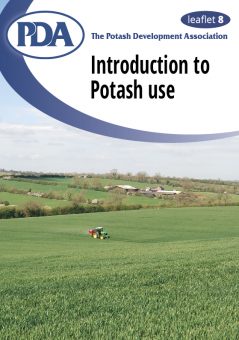8. Introduction to Potash use (1.90M)
pdf 1.90M
8. Introduction to Potash use
Published June 2019
Introduction
Potash is an essential nutrient for all crops, grassland and livestock. Maintaining soil fertility to produce economically viable yields requires the appropriate use of all plant nutrients, of which one of the most important is potassium.
Role of potassium in the plant
Normal plant growth requires large quantities of potassium. In fact, throughout growth most crops contain more potassium than any other nutrient including nitrogen (N). Small quantities of potassium are needed to support many of the crucial enzyme processes within the plant whilst much larger amounts are used to control the water relationships in the plant. Potassium also plays a vital role in the transport of sugars and other products of photosynthesis from leaves to storage organs. Adequate quantities of potassium are thus essential for a crop to achieve its full yield potential. It also has a major role in many aspects of quality such as, grain size and appearance, tuber size, oil content, dry matter and starch content, percentage sugar and fruit ripening and quality.
Many of the functions of potash in the plant are related to physiological conditions and stress. These functions are diverse and include:
- efficient nitrogen and water use,
- drought tolerance,
- frost resistance and
- resistance to pests and diseases.
It is therefore not surprising that a lack of plant-available potash in the soil results in weaker, less vigorous crops that suffer major penalties in difficult growing seasons. In good growing conditions the response to potash may be modest, especially for crops like cereals, but in adverse years its contribution to optimum yields will be substantial. Adequate potassium therefore provides some ‘insurance’ against adverse conditions in difficult growing seasons.
‘Potash’ and ‘Potassium’
Potassium is found in soil solution as the potassium ion, K+, the form that is taken up by plants. However, the potassium content of fertilisers is usually referred to and measured as ‘potash’ or K2O. This is just a convention and ‘potassium’, ‘potash’, ‘K’ and ‘K2O’ are often used interchangeably when referring to fertilisers or application rates.
Soil analysis results are given as mg/litre (or ppm) of K (potassium) which relates to an Index, not to an amount of fertiliser, and should not be confused. If it is necessary to convert K2O to K the value should be multiplied by 0.83. Similarly, K values can be converted to K2O by dividing by 0.83.
Potassium in the soil
Potassium in soil can be thought of as existing in four pools according to their availability of K for uptake by plant roots (Figure 1). It is present dissolved in the soil water, adsorbed onto particles of clay and organic matter and held within the layers of clay particles.

Only small amounts of K are maintained in the soil solution (6-24 kg K2O). The majority of potassium reserves in the soil are held by the negative charges on clay minerals and organic matter (Figure 2). The potassium may be held weakly or strongly according to the position in the clay lattice. K+ which is loosely held (readily available K) is rapidly released for plant uptake, whilst the more firmly bonded reserve (less readily available K) is released more slowly.
Plant roots take up potassium as the cation K+ from soil solution and it is this, plus the readily available K, which is measured by soil analysis as being potentially available to the crop. Together these ‘pools’ can be described as the Exchangeable K.
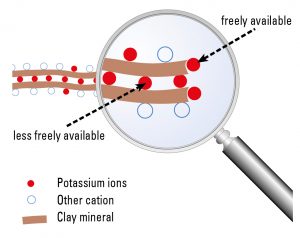
The less readily available K is potassium that has been retained within soil minerals from previous applications of fertilisers and manures or has been released from native soil minerals by weathering. This pool of K is difficult to measure in the laboratory and is not usually determined for advisory purposes. However, field and glasshouse experiments have shown that the K in this pool is slowly available to crops and is a vital source of potassium.
The very slowly available K (or mineral matrix K) is the K in native soil minerals such as feldspars and micas; some soils contain lots of these minerals some very little; the clay content of the soil is not a reliable guide as to the type of mineral. Potassium in the soil minerals is only very slowly released by weathering and the amounts available each year are not sufficient to supply the needs of crop cultivars with a large yield potential.
The essential feature of this concept of the behaviour of soil K is its reversible transfer between the exchangeable and less readily available pools. Thus, when K is added in fertilisers and manures it goes first into the soil solution, from where it is taken up by plant roots. Some of the K is then adsorbed onto the exchange sites, where it is readily available for release back into the soil solution. From these exchange sites K can move to be within the “silicate layers” that constitute the soil minerals. Here the K becomes part of the less-readily available pool of K. However, when K is in demand by the growing crop this K can be released back into the soil solution for uptake by plant roots. The speed and extent of the transfer of K between these pools and the factors that control the transfer are of special concern, especially if farmers stop applying potash.
Potash leaching
Potassium does not leach anything like as readily from soils as nitrate and sulphate. Potash additions not taken up by the crop will be held in the soil by the clay minerals or organic matter as described above. For the great majority of soils, which have a clay content of 5% or more, where normal rates of potash are applied, potassium not used by the crop will remain in the cultivated layer of soil and will not move further down the profile. However, significant losses of potassium can occur when any source of potash (fertiliser, slurry or manure) is applied under adverse conditions i.e. when soil is water-logged, frozen or very dry and deeply cracked. Most of this loss is by surface run-off and can be avoided by following the code of good agricultural practice.
Soils with less than 5% clay (sands and loamy sands) have a much lower retentive capacity for potassium. Such soils, especially if shallow and subjected to heavy rainfall, have a greater risk of potassium loss. On these soils, potash should be applied ‘little and often’ with applications timed to suit crop uptake and amounts carefully matched to crop offtake.
Soil analysis
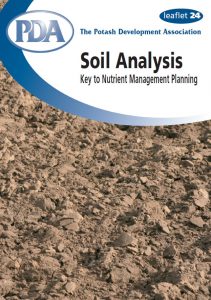 Many decades of detailed research work have resulted in the present soil analysis system as the best practical approach for assessing the adequacy or deficiency of soil potassium supply (see PDA Leaflet 24).
Many decades of detailed research work have resulted in the present soil analysis system as the best practical approach for assessing the adequacy or deficiency of soil potassium supply (see PDA Leaflet 24).
Target soil levels
Trial work conducted at Rothamsted through the 1960s and 70s helped to identify the target levels at which to maintain soil K. They showed that, on many soils, potash reserves which accumulated from applications of fertilisers and organic manures increased crop yields compared to those obtained on similar soils but without such reserves. Also applying fresh K fertiliser to the K-deficient soil, did not increase crop yields to equal those obtained on a soil with an adequate amount of available K.
They also identified that there was no need to continually build up reserves. The yield response curve to soil potassium supply follows the same principles as for other inputs. At very low levels of available soil K, the response to applied potash is large and the response decreases to nil as soil supply increases. Target levels for soil K which represent the level at which K supply is adequate for full yield but not excessive have been established from large numbers of response experiments for different crops (Figure 3).
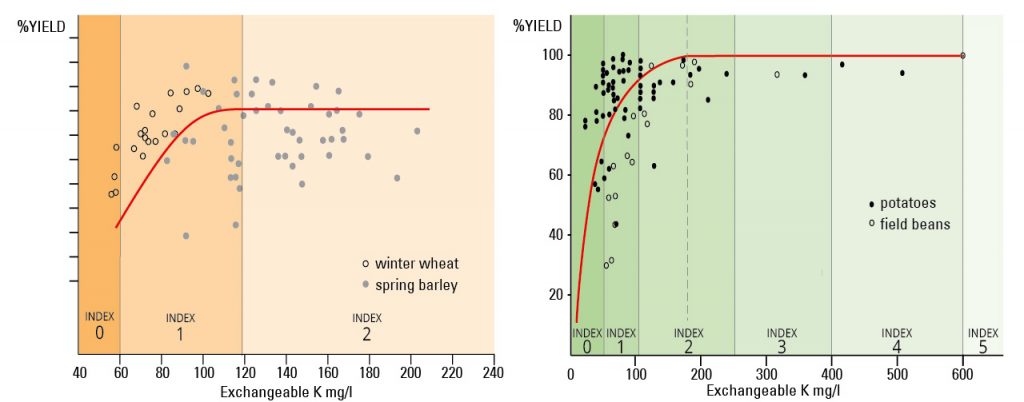
The K index at which yield is close to the maximum can be considered the critical value. Below this the loss of yield is a financial loss to the farmer, above it there is no justification for further increase in the available K.
Current recommendations for potash on arable soils are to maintain the soil at K Index 2- for most crops and at K Index 2+ for potatoes and vegetables (Table 1). Thus, if the crop rotation on an individual field has a significant proportion of potatoes and vegetables the soil should be maintained around K Index 2+. This is because the potash fertilisation policy should apply to the whole rotation of crops on the farm and therefore soil fertility should be maintained.
| Table 1. Target levels of Soil fertility | |||
| Crop | Soil P * | Soil K | |
| Sands/loamy sands ** | Other soils | ||
| Vegetables, pulses potatoes | Index 3 26-45 mg/l |
Upper index 1 100-120 mg/l |
index 2+ 181-240 mg/l |
| Grass, other arable crops | Index 2 16-25 mg/l |
Upper index 1 100-120 mg/l |
index 2- 121-180 mg/l |
* Based on Olsen P. Some laboratories use other extractants.
** These soils cannot be maintained at higher levels of K without risking unacceptable losses. Regular use of organic manures may be of considerable benefit in these situations
Once the soil has been brought to the appropriate K Index for the rotation it should be maintained by replacing the amount of K removed in the harvested crop. This can be calculated from the yield and the concentration of K in the crop. The latter can be found in tables published in RB209 or in PDA leaflet ‘Phosphate and Potash Removal by Crops’. These published K concentrations are averages so it may be that slightly too much or too little will be applied as a maintenance (M) or replacement dressing each year. Consequently, it is sensible to check that potash applications are maintaining the correct level of plant-available K in the soil. This can be done by taking a soil sample every 4 or 5 years from each field for analysis. Preferably, sampling should always be done at the same point in the rotation, at the same time of year and to the same depth.
It should be recognised that potash is unlike most other farm inputs, which are justified on the basis of direct yield response and financial return per £ spent. Correct use of potash to replace crop offtake and maintain soil reserves may not result in an immediate yield response. Failure to replace the potassium removed in the crop and maintain an adequate soil reserve jeopardises future yields and crop quality and unnecessarily exposes the response to all other inputs.
Policies for the lightest textured soils (sands and loamy sands) should be to ensure at least the replacement of removals without the expectation of raising the inherently low levels of soil K to the same values as for other soils.
Benefits of maintaining soil fertility
- Fertile soils have a better distribution of nutrients throughout the soil profile, resulting in more effective uptake, particularly for poorer rooting crops (e.g. potatoes), and better yields than can be achieved from low soil fertility and high fertiliser regimes.
- Soils with adequate nutrient levels avoid the risk of damage to roots from local, high concentrations of salts from large fertiliser applications.
- Satisfactory fertility removes the urgency of timeliness in application of fertilisers, which eases peak work-loads and allows applications to be undertaken at times that will not risk causing damage to soil structure or seedbeds.
- Shortages of any secondary nutrients (e.g. P, K, S, and Mg) will result in poorer responses to nitrogen.
Building soil reserves
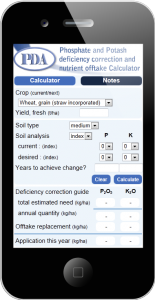
The rate at which reserves in a low K soil should be built up is largely an economic decision. Consideration should be given to the likely loss of crop yield and quality of all the crops grown in the rotation on a low K soil, as well as the cost of fertiliser. Soils vary in their capacity to retain potassium (buffering capacity) and require different quantities of potash to increase plant-available K as measured by exchangeable K.
The quantities required may seem surprisingly large but are a consequence of the fact that some of the added K goes into non-exchangeable reserves that are not measured by soil analysis. In practice, low soil K levels should be improved over a period of years using annual remedial amounts. Heavier soils are less likely to be found with low K levels but will take longer to restore to a satisfactory level than lighter soil.
The PDA Calculator can help to plan application rates to aid build up of soil reserves over a set time period depending on soil type.
Effects of omitting potash
Saving money on potash applications might be appropriate if the soil happens to contain large reserves of K in the less-readily available pool or a large amount of clay that releases potassium. But what are the risks and consequences of getting it wrong?
The effects of omitting potash applications to arable land at or above the critical index of 2- are unlikely to be noticeable in the first few years because of:
- replenishment from reserves;
- seasonal variation in yields;
- effects of soil cultivation and
- uptake of K from the subsoil
There is some evidence that crops traditionally considered very responsive to potash do not respond even on soils with a low K Index. For example, no response by sugar beet to K fertiliser has been reported on some soils at low K Indices. This might be caused by past enrichment of subsoil below light textured topsoil to which large amounts of K have been applied. Deep-rooted sugar beet can probably access this subsoil K. In addition to exploiting potash reserves in the subsoil, greater attention to soil cultivation and improved soil structure will allow plant roots to explore a larger volume of soil for nutrient acquisition. Better cultivations and soil structure may delay the eventual decline in yields as a result of omitting potash, but eventually the ‘crunch point’ will come and there will be too little K available for the crop to achieve its optimum economic yield.
Long term yield implications
In the longer-term, declining soil K will inevitably result in declining yields. This has been demonstrated many times in long-term field experiments at Rothamsted (Table 2).
| Table 2. Implication of declining soil K levels on crop yield (t/ha) | |||
| Exchangeable soil K (mg/kg) | |||
| Crop | 311 | 131 | 36 |
| Potato tubers | 44.30 | 25.20 | 10.10 |
| Sugar beet (sugar) | 7.32 | 5.36 | 2.80 |
| Barley grain | 4.37 | 4.07 | 2.82 |
| Oats grain | 5.04 | 4.49 | 4.62 |
Trials show the decline in yield results in a significant loss of profit, even for cereals at low market prices (Figure 4). The optimum index of 2- (121-180 mg K/kg soil) is clearly identified by the shoulder of the blue line.
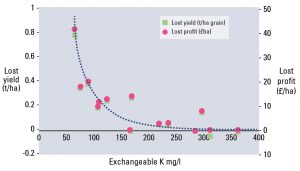
The biggest effects are with those crops that need most potash or have poor root systems which are unable to exploit soil reserves effectively.
Loss of yield is not the only result of potash deficiency in soil. Lack of potash also results in:
- inefficient use of other nutrients, especially nitrogen, a financial cost with the added risk of environmental pollution through nitrate leaching and emissions of nitrous oxide;
- enhanced susceptibility to crop diseases;
- less natural vigour and resistance to stress from pests, diseases and adverse weather;
- weaker straw with greater risk of lodging;
- reduced grain quality.
The decrease in yields with declining exchangeable K in these long-term experiments also emphasise the importance of balanced nutrition – maintaining the supply of adequate amounts of all nutrients. Balanced nutrition involving N x P x K interactions is important to achieve optimum economic yields of good quality produce. The yields of sugar shown in the graph below (Figure 5) illustrate such interactions. With too little nitrogen (N), the sugar beet did not fully exploit the soil to find sufficient K to achieve optimum yield; simply adding extra K fertiliser did not solve the problem. The appropriate amount of readily available phosphorus (P) in soil was essential and, in this case, more important than K. The maximum yield of just over 10 t sugar/ha was achieved with 180 kg N/ha and P or PK.
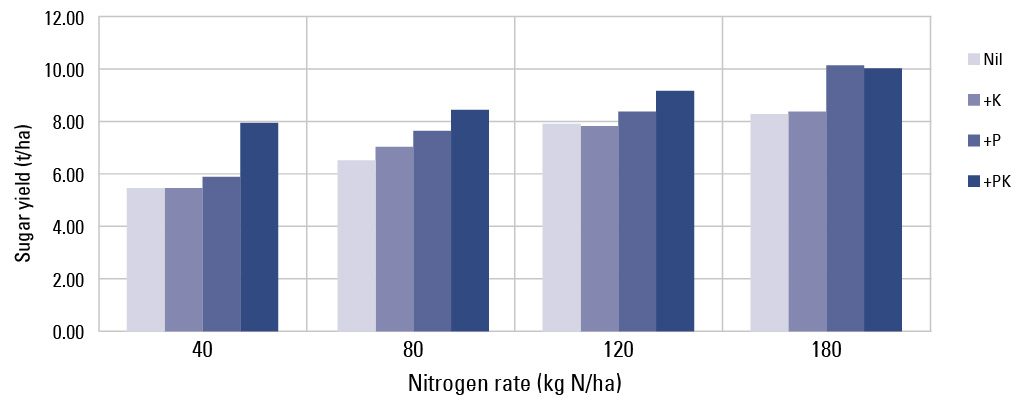
Interactions between N and K are especially important. Many crops contain as much K as N during rapid vegetative growth. Too little K causes ineffective use of N and the potential for N losses to the environment. Experiments with winter wheat at Saxmundham (Table 3) show that, on soils with a low K index (Index 1), first wheats did not respond to more than 120 kg N/ha. Maximum yield only required 160 kg N/ha when the soil was at K Index 2-.
| Table 3. Impact of K index on nitrogen response in winter wheat (t/ha) | ||||
| N applied in spring (kg/ha) | ||||
| K index | 120 | 160 | 200 | 240 |
| 1 | 9.42 | 9.12 | 9.20 | 9.48 |
| 2- | 10.71 | 11.15 | 10.77 | 10.42 |
Fertiliser policy
Following the principles of manuring stated earlier, fertiliser recommendations comprise two components:-
- Replacement of nutrient removed (Maintenance, M) calculated from standard offtake (kg/t) × yield (t/ha)
- Soil fertility adjustment. Additions to improve low soil K, or reductions to allow high levels to decline. These can be made annually to each crop or periodically in larger applications depending on soil type.
These two components vary with soil K Index as shown in the table below. Fine-tuning of the soil fertility adjustment could be done where soil is in the upper or lower parts of Indices 1 or 3. For example, at low Index 1, the fertility adjustment could be +125 kg K2O/ha for vegetables or +45 kg K2O/ha for arable and grassland (see tables below).
Basis of fertiliser recommendations, kg K2O/ha:
| Vegetables: | ||||||||
| Index | 0 | 1 | 2- | 2+ | 3 | >4 | ||
| mg/l | 0-60 | 61-120 | 121-180 | 181-240 | 241-400 | 401+ | ||
| Maintenance | M | M | M | M | M | Nil | ||
| Soil fertility adjustment | +150 | +100 | +50 | 0 | -90 | Nil | ||
| Arable, forage crops and grassland: | ||||||||
| Index | 0 | 1 | 2- | 2+ | 3 | >4 | ||
| mg/l | 0-60 | 61-120 | 121-180 | 181-240 | 241-400 | 401+ | ||
| Maintenance | M | M | M | M | M | Nil | ||
| Soil fertility adjustment | +60 | +30 | 0 | -20 | -90 | Nil | ||
Removal of potash
Under-estimation of K offtake is one of the most common causes for soil K levels to fall below target. This emphasises the need to undertake careful estimations of the amount removed. The removal of straw from a field carries with it a large amount of potash and therefore straw management should also be correctly accounted for to ensure more accurate calculations of removals. Standard figures to calculate removal and therefore replacement needs can be found in RB209 or a separate PDA leaflet ‘Nutrients in crop removals’.
In dry seasons, like 2018, crop removal figures may be higher than average due to the lack of rainfall to wash potassium back into the soil. In these circumstances, taking straw analysis could be a useful indicator of true removals in order to fine tune recommendations.
Fine tuning
Where more site-specific information is available it may be possible to ‘fine tune’ the general offtake guidance. For example, in the case of sugar beet recent studies indicate that the tare-house analysis of root K content (× 1.2 to convert to K2O), used in conjunction with yield provides an accurate indication of potash offtake, see PDA Leaflet 12.
A number of other specific aspects may be considered:
a. Soil structure
Compaction, soil pans or other adverse structural problems can inhibit root growth and thus their ability to take up nutrients from a large volume of soil. ‘Fertility’ embraces other factors as well as nutrients, including soil aeration and water availability and organic matter content. Improvement of these factors leads to better biological activity in the soil and more readily available nutrients. These aspects should be a starting point not an after-thought in fertility management.
b. Soil depth
Soil analysis measures the available nutrients within the sampling depth – normally 15 cm for arable soils and 7.5 cm for permanent grassland – and in soil particles less than 2 mm in diameter. The amount of soil in this size range that can be explored by roots is important. Thus, soil depth and stone fraction can affect nutrient availability, and should be considered when interpreting soil analysis results. Whilst nutrients are generally most concentrated in the plough layer, it is clear that modern high-yielding, well-rooted crops derive considerable amounts of potash from greater depth. It may be valuable to estimate the likely supply of K by analysing samples taken at depth for soil N. However, interpreting the results may not be easy because there is little information on the amount and distribution of roots at depth.
c. pH
A larger proportion of applied potash tends to become non-exchangeable on neutral and calcareous soils than on soils with pH around 6. Additions of fertiliser to improve low K status will have less impact on such soils and this needs to be considered when calculating fertiliser requirements.
d. High magnesium soils
Potassium availability may be affected on soils with very high Mg levels. It has been suggested that where the concentration (mg/l) of soil Mg is more than twice that of soil K, potash availability to the crop may be less than implied by the actual potassium analysis value. In such circumstances no more magnesium in any form should be applied to the rotation and higher applications of K may be used to overcome the imbalance. The application of calcium to replace the magnesium is not recommended, principally because it will also displace K.
e. Non-exchangeable K
There is still no practical method to estimate the supply of slowly released K, which will vary greatly between soils and between seasons. For some heavy soils it may be sufficient to provide all the needs of combinable crop rotations and permit applications for root rotations to be halved. However, this does not apply to all clay soils. On lighter soils, allowance for non-exchangeable K should only be made where objective information or experience is available.
Organic manures
Inadequate allowance for the nutrient contribution from manures is still frequently made. Use standard figures unless specific analysis is available for consistent materials, and deduct the total amount of potash in manure applied if the soil Index is 2 or more. For soils at Index 0 or 1, K added in manures can be thought of as helping to increase soil reserves and normal applications of fertiliser K should be made.
Timing
Crops take up very different amounts of K during growth but all need a readily available supply in the soil at key times. For potatoes, two-thirds of the season’s requirement is taken up in the six weeks after plant emergence. For winter cereals a small amount is needed for establishment but most is taken up in the short period between tillering and ear emergence (Figure 6). During periods of rapid growth crops can take up as much as 10 kg K2O/ha each day from the soil. As crop yields continue to increase with better varieties and agronomy, the total amount of readily available K in the soil must be able to satisfy the demand of the crop.
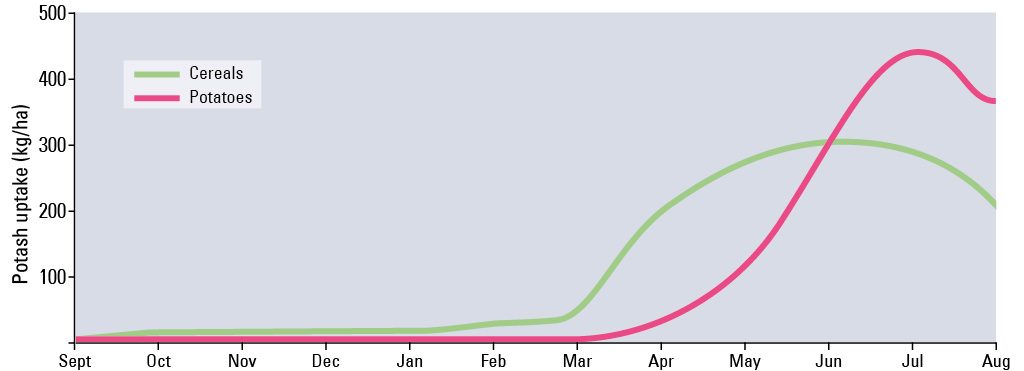
Individual recommendations for specific crops are detailed in other PDA leaflets.

